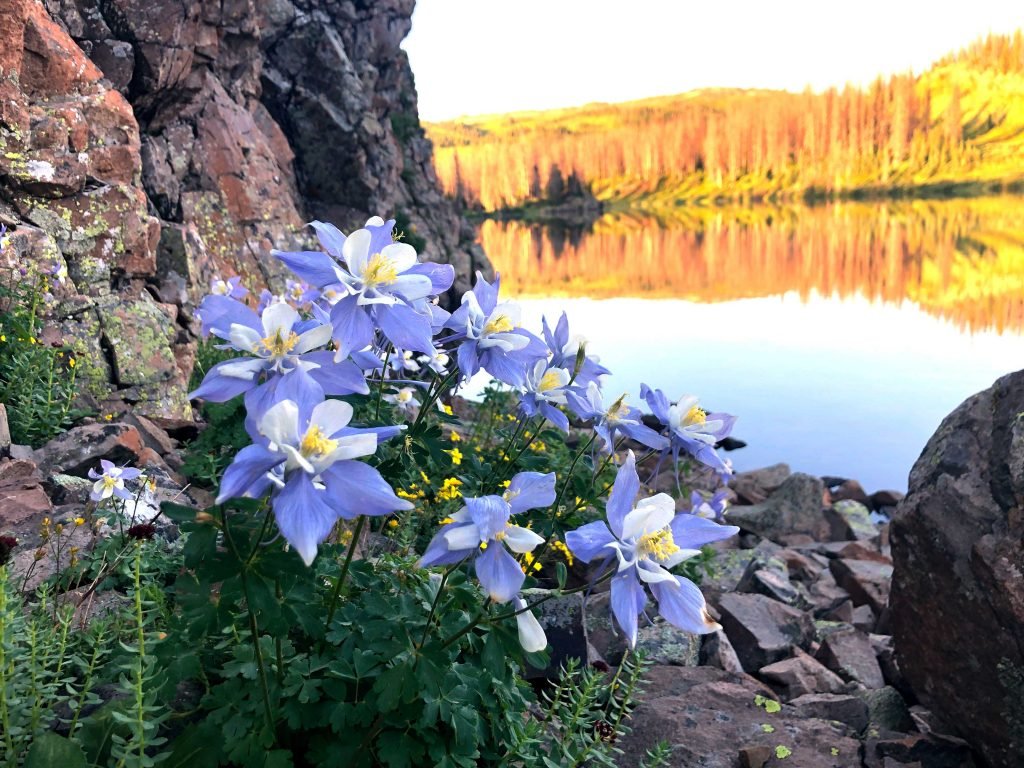By Gregg Goodland
Public Affairs Officer, Rio Grande National Forest
We left the trailhead with fully loaded backpacks for several days of camping in the Wilderness. Just two miles from the trailhead, we crossed the imaginary line into the South San Juan Wilderness Area.
Another mile up and that familiar sprinkle that would eventually develop into a full blown, monsoon-driven thunderstorm prompted us to don raingear for both us and our backpacks. The marble-sized hail soon had us hunkering under the trees with the widest canopy we could find.
As the ground turned white and lightning blasted around us, we did venture to wonder why these two soaked humans were even in that area under those less-than-friendly conditions. As the rain subsided and we pressed on, the reason became increasingly clear with each step towards our high lake destination — Blue Lake.
Four miles into the Wilderness area lies one of the most serene lakes I have ever been to. This was definitely the reason I chose this location for my daughter and I to spend some quality time together. The rest of our trip was wonderful, albeit fairly wet. This was her first backpacking trip into a Wilderness area and she truly loved the experience, especially after the two groups of “others” left that next day and we had the place to ourselves for the following two days.
We’ve all heard and probably used the term “wilderness,” but what does it actually mean? And why did I not capitalize it this last time? Oxford Languages defines it relatively bluntly as “an uncultivated, uninhabited, and inhospitable region.”
Merriam Webster more softly states “a tract or region uncultivated and uninhabited by human beings” and “an area essentially undisturbed by human activity together with its naturally developed life community.” Most of us simply say “the middle of nowhere.”
But you get the point; wilderness is not the populated areas where things are developed for human use. They are mostly all about nature.
Then there are designated Wilderness Areas. These are the congressionally designated areas of federal lands that are set aside for nature to be natural. The capitalization comes from the reference to an actual named Wilderness Area such as the South San Juan, Sangre de Cristo, Weminuche, and La Garita Wilderness Areas, of which the Rio Grande National Forest has a portion within its boundaries.

The 1964 Wilderness Act, written by The Wilderness Society’s Executive Director, Howard Zahniser, created the National Wilderness Preservation System, which protects nearly 112 (now 118) million acres of wilderness areas from coast to coast.
With the first draft of the bill birthed in 1956, it was designed to protect some of the nation’s last remaining wilderness. After eight years and 66 revisions, President Lyndon B. Johnson signed the Wilderness Act into law on Sept. 3, 1964. Sadly, Zahniser had passed away only four months earlier.
The foundation of the act is that it is “an area where the earth and community of life are untrammeled by man, where man himself is a visitor who does not remain.”
While we had a great time and truly felt a connection with the amazing landscape, my daughter and I certainly FELT like visitors on that trip. Like we didn’t belong. But yes, we CAN visit areas like this. If for no other reason than to understand the grandeur of our natural world and how we can, and should, treat it with respect.
Since the Act was signed nearly 60 years ago, there have been numerous additions of large tracts of land to the System, including the 1980 act in which the South San Juan Wilderness was designated. The 59th anniversary of the Wilderness Act was on September 3.
Please join me in a personal reflection on what these true conservation visionaries gifted us. I would hope that these wild lands will remain forever available for all people to view from afar and even visit occasionally, but to leave without impact and allow that land to remain constantly changing, only through natural processes.
Gregg Goodland is the Public Affairs Officer for the Rio Grande National Forest. An avid outdoor enthusiast, he promotes the responsible and safe use of our public lands.


